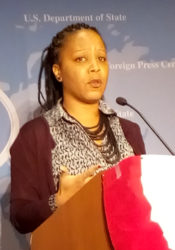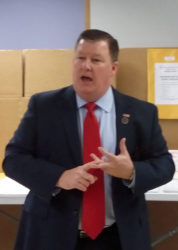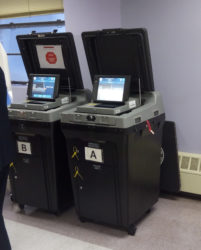By Zoisa Fraser in New York
(Stabroek News is one of two Caribbean media houses chosen to participate in the US Election Tour organised by the US Department of State’s Foreign Press Centre.)
Millions of New Yorkers will take to the polls today for the first time having been excluded from the early voting process and all assurances have been given that the chances of voter fraud and rigging are near impossible.
Director of Communications Bronx County Board of Elections Valerie Vazquez told foreign journalists participating in two elections tours that there are 1,205 polling places throughout New York City (NYC) and they will all close at 9 pm. These polling stations are expected to service 4.5 million registered voters.
“The availability of the results depends on how quickly the process is uploaded. We wouldn’t give an exact time; we really don’t know,” she said.


The journalists were earlier told that no early voting takes place in NYC. The early voters have turned out in impressive numbers in several states including Ohio.
Asked why there is no early voting in NYC, Vazquez responded, “It’s just something that was approved by the legislature.” She could not say which other state was in this position. “But I know we do not and in order for that to happen… the New York State Legislature would have to take a position. All we have is absentee vote. You can vote in advance but it is not counted until after the elections. You have to have a reason. You have to come in here and fill out an application, check it off and say I’m gonna be out of the country …”
She said people would go to the bureau particularly to fill out their absentee ballots.
According to Vazquez, NYC transitioned to the current voting process in 2010. “So people are fairly comfortable with it,” she said adding that not many come in seeking information about the process.
Told that in Guyana an index finger is stained with a special ink as an indication that a person has voted, she said that in the United States it is different as there are no physical means of verifying that someone has voted. Rather there is an automated record taken by a special type of voting machine.
“You don’t get a slip. There is no confirmation. You don’t get a physical receipt.
The only thing that you have is on the screen… A notice that says your vote was counted,” she said.
Executive Director of the Board of Elections Michael Ryan took journalists through the voting process. He said these are systems in place to facilitate those with disabilities, whether physical or visual and those in wheelchairs.
He explained that when persons walk into the polling site there is an information table where they can get assistance if they don’t know their elections district. Once armed with this information they are permitted to go straight into the poll room where they are handed a ballot after their information has been verified.

He said the voter then signs the poll book and explained that New York is a non-ID state which means that identification does not have to be presented in order to receive a ballot.
According to Ryan, the ID is only presented if you are a first time voter and have failed to provide officials with the last four digits of your social security number or non-driver or driver’s licence or any other document that could identify who you are and ties you to the address given. There is some translation at polling sites to assist those who cannot speak English.
He said the ballot is then taken to one of the privacy booths where it is filled out and placed in a privacy sleeve. Thereafter the voter places it into a scanning machine. He said the machines, which are locked, will scan and accept the ballot. Ryan explained that at the close of poll the machines are shut down, the door is opened and the contents taken out and sealed. He said the police then take custody of all the voted material and transports them to the designated areas. “The NYPD is fully integrated into the voting system… that goes back to before the turn of the last century,” he said adding that it has always been done this way because the police were seen as not only a security force but also as independent of the political process.
He said the machines are also equipped with two portable memory devices – the primary and the backup and here is where the elections material are housed. The devices look like flash drives.
One stays in the machine, which is delivered back to the various sites and is deemed the official results while the other is removed and placed with the election material which is taken to police locations throughout the city. Prior to that happening, he said, the unofficial results for each machine are uploaded on a tablet device, using an in-house written software.
If for some reason there is an issue with WIFI connectivity at a particular location, the information from the machines is placed into the internal memory of the tablet and once the connectivity is reestablished it is unloaded sequentially in the order of receipt from the time stamps. “We are able to monitor that remotely… They are not only inscripted, but they have a code,” he said.
Voter fraud
Meanwhile Dr Christina Greer of Fordham University, during a briefing session with journalists at the Westin Hotel, made it clear that the likelihood of voter fraud is “very minimal” but said that there are still several concerns by the populace including the fact that the voting machines can be hacked.
Asked later what guarantees the security of the process, she said that unlike the 20th century persons going to the polls multiple times is not seen.
She said the people who work at the polling stations are sworn officers and are expected to be honest. “So if you cast a ballot they are there to make sure that that ballot goes where it needs to go.
They should not sort of look at you and make some assumptions about who you’re going to vote for and then trash your ballot, right? That is — we traditionally have not seen that. There are some concerns, though, that people have in this election, that people will look at certain demographics, largely people of colour and immigrants, make assumptions that they’ll be voting Democrat, and then have their ballots tossed,” she said.
According to the professor, another concern people have was the move by many states from a paper system to an automated system. “So in New York we still have a ScanTron system. We’re a little behind the times sometimes in New York, but paper is good. Right? So we actually fill out our ballots with little dots, just like you all probably did in high school when you were taking a big exam.
And then we put it in the scanner and that’s what happens,” she said.
“Other states, though, are so automated, they actually don’t have a paper trail and it’s just a touch screen, sort of like if you’re going to the ATM. That concerns a lot of people on both sides of the aisle because some people have complained [with] early voting if they hit Hillary Clinton, it jumps to Trump, or if they hit Trump, it jumped to Hillary Clinton. And those are machines that can actually be programmed, but they can also be hacked,” she said.
Dr Greer who said she will be voting for Clinton said that a win will come from the votes of African-American women, Latinos and Asian-Americans.
“In most of our polling, we don’t ever ask about Asian-Americans. It’s Black, White, Latino. And Asian-Americans have been trending Democratic, especially in the presidential level, steadily for the past three elections.
But we just ignore them in our polling which is highly problematic,” she said.
She pointed out too that Latinos are going to be “incredibly important.”
Meanwhile, President of Global Strategy Group Jefery Pollock expressed confidence in a Clinton win and said that the swing state of Ohio will not be critical if there are big wins in other key states.
He said that while polls show that Trump has a slight lead over Clinton in Ohio, the polls conducted in other swing states are showing encouraging results.
Responding to questions from the media on the closeness of the race in Ohio, he acknowledged that this state has been key for years but expressed view that this has changed. “I don’t think it is anymore… at least in this election cycle. I can’t say whether Hillary Clinton will win or lose… in Ohio but there have been a number of recent polls which showed her down by a couple of points.
But let’s pretend for the sake of argument that she doesn’t win Ohio. The point of the Electoral College is that she doesn’t actually need Ohio to win, that the rest of the states make up for it,” he said.
Late last week, Stabroek News was in Ohio and the Clinton office located there was confident of a win despite the poll results.
According to Pollock, what is happening and what has “turned it [this elections cycle] on its head” is that more white college educated voters are voting for Clinton and more downscale whites voting for Trump.
He reasoned that Ohio fits into the more downscale white voters and this would be what may be driving a Trump win.
“Hillary has been able to build a lead on the back of these white educated collage voters,” he said adding that for example in the suburbs of Philadelphia and in Pennsylvania she needs to win big in order to win the elections.
He said they will be waiting for North Carolina, Florida and Pennsylvania, all swing states, which are critical to a Clinton victory.
He said the Democratic party is poised to do well in states such as Illinois, Colorado, Wisconsin, Pennsylvania and Nevada.
“Most polls have a two point or less margin.
All these races seem to be incredible tight going into elections,” Pollock said adding that this is because of the massive partisanship that exists.




